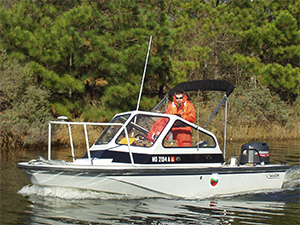 The Maryland Coastal Bays are a treasure rich with fish and birds. The health of the bays is influenced by activities that occur within the watershed. Nutrients, sediments and chemicals are transported to the bays via surface runoff and groundwater. The biggest concern for the bays health is eutrophication due to the high nutrient loading.
The Maryland Coastal Bays are a treasure rich with fish and birds. The health of the bays is influenced by activities that occur within the watershed. Nutrients, sediments and chemicals are transported to the bays via surface runoff and groundwater. The biggest concern for the bays health is eutrophication due to the high nutrient loading.
The Coastal Bays Monitoring Program measures key components of the ecosystem, including pollutant inputs, water quality, habitat and living resources. The information is vital for evaluating the progress of management actions aimed at protecting and restoring the Coastal Bays and tributaries and to provide guidance for future actions. Monitoring data is also used for research and efforts to model the ecosystem.
What we monitor and why
Dissolved oxygen is low in some areas
Although the Coastal Bays are shallow lagoons which typically do not stratify, oxygen values were frequently low in some areas. Dissolved oxygen (DO) data sources show that Bishopville Prong, Shingle Landing Prong, areas of the St. Martin River, dead-end canals and some areas in Chincoteague Bay have poor fish and crab habitat (DO < 3mg/L) during summer months. Additional areas that have DO levels below the state criteria of 5 mg/L include Ayer, Trappe, Newport, Marshall Greys, Manklin, Herring and Turville Creeks, as well as areas in Chincoteague Bay. Areas that have < 5 mg/L DO during the day may provide stressful habitat at night.
The Coastal Bays Water Quality Monitoring Program began in 1999. The current program includes 46 routine water quality monitoring sites dispersed among the six bay segments and four continuous monitoring sites. The monitoring program involves many components including monthly ambient water quality monitoring used in determination of current condition (measure of water quality parameters that meet specific goals or targets) and long-term trends (analyses that detect and quantify water quality responses to nutrient reduction actions).
 Long-term Monitoring
Long-term Monitoring
The long-term Coastal Bays Water Quality Monitoring Program is a comprehensive water quality and habitat monitoring program. Started in 1999, this program collects data 12 times a year at 46 fixed stations located in Maryland’s Coastal Bays. The monitoring program assesses water quality by measuring the levels of nutrients as well as closely related habitat conditions such as dissolved oxygen and water clarity.
Continuous Monitoring
 The continuous monitoring program deploys instruments that collect water quality data (temperature, salinity, pH, dissolved oxygen and turbidity) every 15-minutes each day they are deployed. There are 4 Department of Natural Resources stations in the Maryland Coastal Bays (and x National Park Service sites). Some stations provide real-time data via cellular telemetry.
The continuous monitoring program deploys instruments that collect water quality data (temperature, salinity, pH, dissolved oxygen and turbidity) every 15-minutes each day they are deployed. There are 4 Department of Natural Resources stations in the Maryland Coastal Bays (and x National Park Service sites). Some stations provide real-time data via cellular telemetry.
National Coastal Assessment
Maryland DNR was awarded a 5 year grant from the US EPA in 2000 as part of the National Coastal Assessment initiative. The current National Coastal Assessment is a two-year effort to survey the condition of the Nation's coastal resources by creating an integrated, comprehensive coastal monitoring program among the coastal states.